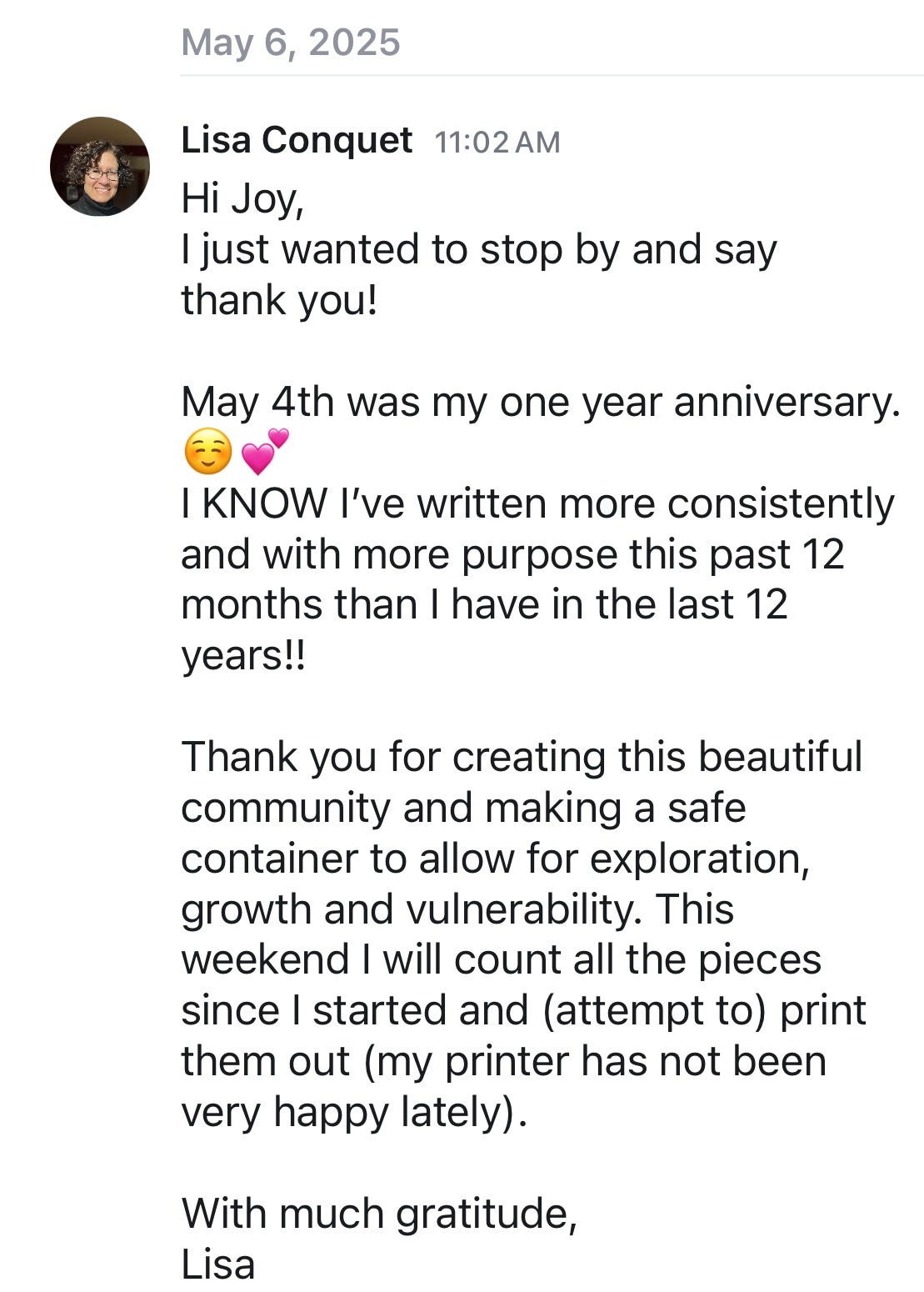How to build a 200+ member writing community
What to do first and why
Three years ago, I launched my online writing community, Sustenance and promptly panicked. Would this thing actually survive? Would I find enough members? Could I offer enough value? 24 hours later, my best friend talked me out of tanking the whole thing, offering a sheepish apology, and refunding everyone’s money.
She said: You owe it to yourself (and to your 17 members) to really give this thing a fair shot.
And so that’s what I did. Today, Sustenance is a thriving community that supports 200+ poets and essayists to learn craft, find consistency, and publish. We have a waitlist of over 1K folks and, due to demand, can only open doors 2x a year to keep from exceeding our cap.
Fun fact: We’re opening June 12th for enrollment only to those on the waitlist (if you’re interested—this is the last chance to join until 2026). You can get on the invite list here.
After my launch, I spent the year studying exactly how to make a community thrive. I already had an MA in Creative Writing, years of teaching, and a book deal, but I wasn’t sure how to truly build a sustainable business. So I read a lot of books, joined communities for community builders, constantly surveyed my current members to better elevate their experience, and finally invested in my own coach.
What people think you need to start an online cohort or community:
A massive social media presence + network
A recognizable brand with a great logo
Professional photography and beautifully designed graphics
Years of marketing experience
Don’t get me wrong. These things are great, but they’re not the nuts and bolts of a sustainable business model. This list came much later for me. These things definitely impact scale and reach, but they won’t make or break your essential community.
What you actually need to start a viable community:
A clear picture of who you serve
It’s vital to know who your community is for. What does your ideal community member most want from you? How can you uniquely help them? What outcome does your community promise?
To get the answer to these, do some ground research. Send out polls and sit down with past clients. Study communities similar to yours and decipher who they attract. Interview people who are the kind of member you’d like in your community. This gives you a blueprint into your best-fit member’s wants, needs, and concerns. It dually empowers you with an enhanced vocabulary to directly speak to that ideal member persona. In other words, extensive conversation gives you your brand messaging without the guesswork. You can adapt your model and messaging to best serve the people you want to attract (and they’re out there telling you exactly what they want).
When you get clear on who you serve, you’re able to approach folks confidently. It takes the pressure off of feeling like you have to “market.” You’re simply communicating true value and adapting your offer to serve them.
An example of Sustenance’s best-fit member:
Sustenance serves craft-driven essayists and poets who are serious about craft. Our best-fit members are writers who want to actively contribute and intentionally elevate their craft.
A defined transformation
Once you have a clear offer (informed by research and interviews), you should be able to outline a transformation. It doesn’t have to be big, but it should be meaningful. You should be able to say it in a sentence or two.
Tom Ross, who has been a mentor to me, offers a clear transformation in his community for community builders: We help aspiring community builders to plan and launch their first online community. We also help folks who are running existing communities to scale and improve them.
Similarly,
helps Substack writers increase their subscribers, get real engagement, create incredible opportunities, and earn an income.In Sustenance, our transformation is also super clear: We help writers find community, develop a consistent and nourishing practice, publish, and get into MFA programs.
(And we don’t just talk about transformation, we document it too. Check out our big community wins from just this year so far). Gosh, I’m so freaking proud.
A sustainable pricing model
When starting your community, it’s important to create a price range that both rewards your work but also clearly illustrates worth. Free communities don’t tend to work because people don’t often recognize them as truly valuable. Paying yourself is also powerful motivation to help avoid burnout.
Additionally, I recommend against monthly enrollment for a community. It might be appropriate in the beginning while you’re still attracting members, but it’s a drag longterm. Not only does it mean endless marketing for you, but it means constantly having to welcome new people. This creates fatigue for both you and your existing members. Sustenance is an annual enrollment and when folks join, they know they’re going to study and write with the same group of writers for at least a year. This helps members relax, bond, and invest in one another. Folks get exhausted by decision fatigue. They don’t want to decide every month if they’re using a subscription. Quarterly, or better yet, annual memberships create a sense of belonging.
In addition, every enrollment period, Sustenance raises it rates. This isn’t me just being an asshole. It strategically builds retention and honors how much more valuable a community becomes over time. Over the past years, Sustenance has grown its replay library to over 50+ guest speakers like Ellen Bass, Pam Houston, Anis Mojgani and even newly named Pulitzer Prize winner Marie Howe. We’ve brought on three resident professors who routinely give feedback and teach (in addition to me) and a deeply invested community director (hi,
). Over time, Sustenance’s value has dramatically deepened and increasing the annual rate reflects that.A willingness to start small + iterate
Sustenance is capped at around 250 members, but it didn’t start that way. Before I launched such a large container, I started offering individual workshops. When those started selling out, I expanded to a larger 4 week container. From there, I opened a small community of under 50 people. Starting small mitigated risk and built my confidence. Not only did starting small validate my concept, but it also provided a pool of dedicated writers who were excited to jump in when I designed a more robust offer (thanks
, , Mary Lynn, Meg and Marci). xxBehold, here are the iterations of my teaching model when I first started until I finally arrived at Sustenance. You can also see the difference hiring a professional designer made. 😂



In the early days of Sustenance, I surveyed my community nearly monthly. I was building fast and immediate feedback was crucial. Having an initially small community meant intimacy. It meant I could onboard each member individually and truly find out what they needed. I also wanted to foster a relationship of transparency. I wanted folks to tell me exactly what wasn’t working so I could fix it. Building a strong feedback loop was one of the things that helped Sustenance truly succeed. Make sure you have a culture of constructive feedback, trust, and transparency—it will build or break your community.
An investment in live learning
Here’s a hard truth: passive learning is dead. No one wants to watch video alone or learn in a vacuum. No one really wants to work through modules and type long feedback. It’s why remote video learning always fails. Our brains just don’t work that way. We learn via connection.
So how can online communities build powerful culture? The answer is live events. Or as I like to say: Get your ass to (Zoom) class.
As I built Sustenance, I’ve kept the emphasis on learning live. We have small weekly groups, generative sessions, guest speakers, essay club, and open mics. We offer 6-10 events monthly and I teach about half the time. Replays are always available, but magic happens live.
Breakout rooms are a huge part of what we do (even when they feel scary). Some community builders say every single event should have breakout rooms (sweet spot is 2-3 people in a breakout room for about seven minutes). The key is to facilitate direct member connection as much as possible.
I also heavily encourage in-person meetups among members. In-person bonds transform online relationships. And I can’t tell you what a thrill it is to hang with members in real life.



Bonus tip: Rookie communities have a tendency to over-program. They figure more is better, but I’ve found offering roughly one live event per week is golden. Communities don’t have to be noisy to be deeply healthy.
A commitment to build community, not cults
The tell-tale sign of a doomed online community is how much it focuses on its founder. In my opinion, hero worship has no place in communities. I often see influencers building communities that revolve around themselves. They promise intimate access to their inner world, behind-the-scenes stories, exclusive personal content etc. In addition to giving me a bit of the ick, I just don’t think it’s a viable community strategy.
Communities are designed to share knowledge. They aren’t vanity metrics. Sustenance isn’t about me, it’s about making sure each member is deeply served and supported.
True community relies on dissolving hierarchies and creates communal wisdom, shared initiative, and collective ownership. I still teach 3-4x monthly in my community, but we also have core groups, member-led sessions, and joint teaching with other MFA-level resident profs. I only know so much, but with shared community, we all get wiser faster. (And I am consistently blown away by how brilliant my members are).
The bottom line:
Communities are a bit like long-burning fires. They require a lot of fuel, careful structure, and watchful tending. You must be passionate about people and caring for them. You must want to serve and learn ravenously. You must be willing to grow at a sustainable pace and build a truly authentic culture. And you must adapt to the evolving needs of the people who trust you enough to join your inner circle. xxx
Interested in joining Sustenance? Doors open to the waitlist on June 12th. You must be on the list to receive the link There are 40 open spots and over 1100 people on the waitlist. First come, first serve on launch day. Doors close when spots fill (we sold out in minutes last time). This the last chance to join at the current rate before tuition increases next quarter.
What questions do you have about building an online cohort or community? I’ll answer them in the comment section below. xx








Let me know what questions you have about community building and I'll answer them here! xx
I’ve said it before and I’ll say it again: Sustenance is one of the best investments of my whole life. Not only did it help me create my consistent writer’s life, I’ve also been published, and created true friendships with people who I adore. And learning from some of my actual writing heroes is such a thrill! I pulled together some of my fave writerly advice from some of those workshops last year: https://open.substack.com/pub/jordansheapage/p/years-worth-of-life-advice-for-writers?r=1qh4lt&utm_medium=ios
Thank you, Joy! ❤️